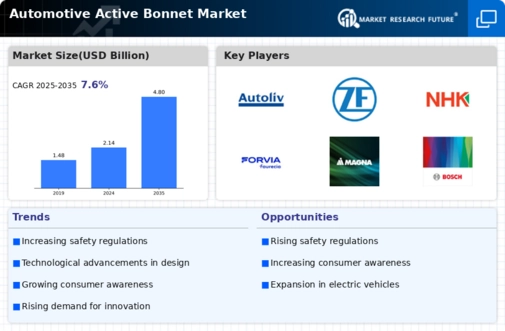Market Growth Projections
The Global Automotive Active Bonnet Market Industry is projected to experience substantial growth over the next decade. With a market value of 2.14 USD Billion in 2024, it is expected to reach 4.8 USD Billion by 2035. This growth is underpinned by a compound annual growth rate of 7.62% from 2025 to 2035. The increasing emphasis on pedestrian safety, coupled with advancements in automotive technology, positions the active bonnet market for significant expansion in the coming years.
Increasing Safety Regulations
The Global Automotive Active Bonnet Market Industry is experiencing growth due to the implementation of stringent safety regulations aimed at reducing pedestrian injuries during accidents. Governments worldwide are mandating advanced safety features in vehicles, including active bonnets that can mitigate the impact on pedestrians. For instance, the European Union has introduced regulations that require pedestrian protection measures in new vehicle models. This regulatory push is likely to drive the adoption of active bonnet systems, contributing to the market's projected value of 2.14 USD Billion in 2024.
Technological Advancements in Automotive Safety
Technological innovations are significantly influencing the Global Automotive Active Bonnet Market Industry. The integration of sensors and actuators in active bonnets enhances their functionality, allowing them to deploy in milliseconds upon impact. This rapid response capability is crucial for minimizing injuries to pedestrians. Companies are investing in research and development to improve these technologies, which is expected to propel the market forward. By 2035, the market is anticipated to reach 4.8 USD Billion, reflecting the growing emphasis on advanced safety features in vehicles.
Consumer Awareness and Demand for Safety Features
There is a noticeable increase in consumer awareness regarding vehicle safety, which is positively impacting the Global Automotive Active Bonnet Market Industry. As consumers become more informed about the benefits of active safety features, they are more likely to choose vehicles equipped with such technologies. This shift in consumer preference is prompting manufacturers to incorporate active bonnets into their designs. The growing demand for safer vehicles is expected to contribute to a compound annual growth rate of 7.62% from 2025 to 2035, indicating a robust market trajectory.
Growth of the Automotive Industry in Emerging Markets
The expansion of the automotive industry in emerging markets is a significant driver for the Global Automotive Active Bonnet Market Industry. Countries such as India and Brazil are witnessing a surge in vehicle production and sales, leading to an increased focus on safety features. As these markets develop, the demand for vehicles equipped with advanced safety technologies, including active bonnets, is likely to rise. This trend is expected to further bolster the market, aligning with the overall growth of the automotive sector in these regions.
Collaboration Between Automotive Manufacturers and Technology Providers
Collaboration between automotive manufacturers and technology providers is fostering innovation within the Global Automotive Active Bonnet Market Industry. Partnerships are being formed to develop cutting-edge active bonnet systems that enhance vehicle safety. For example, automotive companies are working with tech firms to integrate artificial intelligence and machine learning into active safety systems, improving their effectiveness. Such collaborations are likely to accelerate the adoption of active bonnets, contributing to the market's anticipated growth trajectory.









